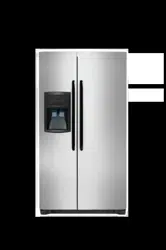Documents: Go to download!
User Manual
- User Manual - (English)
- Owners Manual - (Spanish)
- User Manual - (French)
- Specifications - (French)
- Specifications - (English)
- Energy Guide (English, French) - (French)
- Installation Instructions (English, Spanish) - (English)
- FEATURES AT A GLANCE
- INSTALLATION
- CONNECTING THE WATER SUPPLY
- CONTROLS
- STORAGE FEATURES
- AUTOMATIC ICE & WATER DISPENSER
- NORMAL OPERATING SOUNDS AND SIGHTS
- CARE & CLEANING
- BEFORE YOU CALL
Table of contents
FEATURES AT A GLANCE

INSTALLATION
Location
- Choose a place that is near a grounded electrical outlet. Do Not use an extension cord or an adapter plug.
- If possible, place the refrigerator out of direct sunlight and away from the range, dishwasher or other heat sources.
- The refrigerator must be installed on a floor that is level and strong enough to support a fully loaded refrigerator.
- Consider water supply availability for models equipped with an automatic ice maker. If you do not hook up water to the refrigerator, remember to turn the ice maker off.
CAUTION: Do Not install the refrigerator where the temperature will drop below 55°F (13°C) or rise above 110°F (43°C). The compressor will not be able to maintain proper temperatures inside the refrigerator. Do Not block the toe grille on the lower front of your refrigerator. Sufficient air circulation is essential for the proper operation of your refrigerator.
Installation
Installation clearances
Allow the following clearances for ease of installation, proper air circulation, and plumbing and electrical connections:
Sides & Top 3 /8 inch
Back 1 inch
NOTE: If your refrigerator is placed with the door hinge side against a wall, you may have to allow additional space so the door can be opened wider.
Toe Grille Installation and Removal
To install toe grille
- Open both doors. Slide left and right sides of toe grille over lower hinges of refrigerator.
- While pushing toe grille firmly against cabinet, fasten bottom clips of toe grille to cabinet.
- Fasten top clips to cabinet.
- Close the doors. Fasten right and left side clips into groove of bottom hinge.
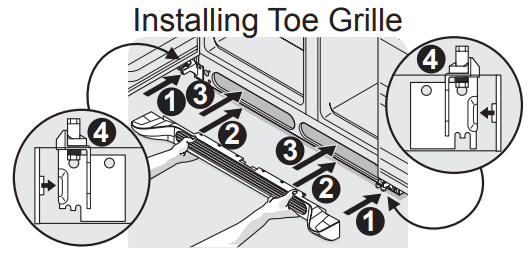
To remove toe grille
- With both doors closed, unfasten right and left side clips of toe grille from bottom hinge groove.
- Open both doors. Press firmly on top of toe grille until top of toe grille pops off.
- Pull toe grille outward toward your body and off of lower hinges.
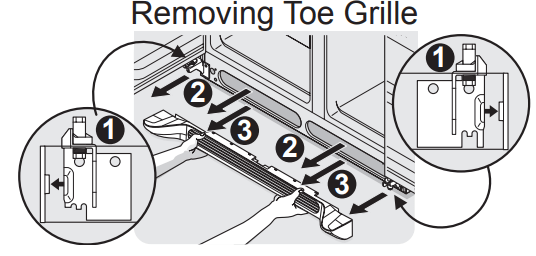
Door Opening
NOTE: The refrigerator doors are designed to shut by themselves within a 20 degree opening.
Your refrigerator should be positioned to allow easy access to a counter or table when removing food. For best use of drawers and freezer baskets, the refrigerator should be in a position where both the refrigerator and freezer doors can be fully opened.
Guidelines for final positioning of your refrigerator:
- All four corners of the cabinet must rest firmly on the floor.
- The cabinet should be level at the front and rear.
- The sides should tilt ¼ inch (6 mm) from front to back (to ensure that doors close and seal properly).
- Doors should align with each other and be level.
All of these conditions can be met by raising or lowering the adjustable front rollers.
To level the cabinet using the front rollers:
- Open both doors and remove the toe grille
- Close the doors and use a flat-blade screwdriver or 3 /8 inch socket wrench to raise or lower the front rollers.
- Ensure both doors are bind-free with their seals touching the cabinet on all four sides.
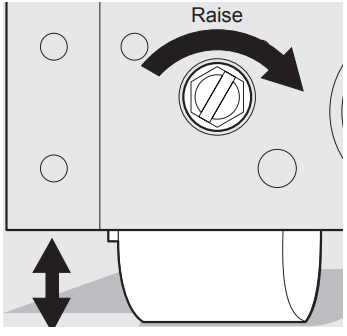
To level the doors using the adjustable lower hinge:
NOTE: Some models will not have a set screw. For those models follow steps 2 through 4.
1. Before leveling either door, remove set screw that locks door height into position. (The door cannot be adjusted without set screw removed).
2. If the refrigerator door is lower than the freezer door, raise the refrigerator door by turning the adjustment screw clockwise using a 7 /16 inch wrench.
3. If the freezer door is lower than the refrigerator door, raise the freezer door by turning the adjustment screw clockwise using a 7 /16 inch wrench.
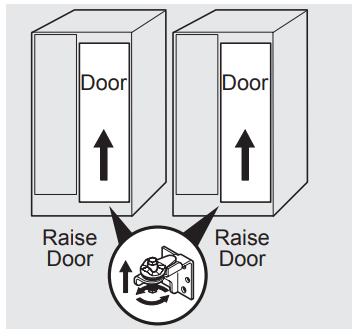
4 After leveling, verify door stop contacts lower hinge and top of door does not contact upper hinge through full movement of door (from fully closed to fully open).
5 Reinstall set screw, locking the door height.
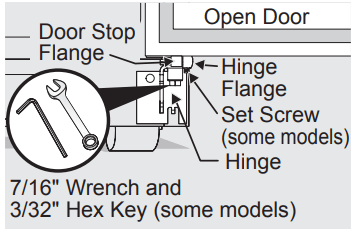
6 Replace the toe grille by fitting it into place
CONNECTING THE WATER SUPPLY
WARNING: To avoid electric shock, which can cause death or severe personal injury, disconnect the refrigerator from electrical power before connecting a water supply line to the refrigerator.
CAUTION: To Avoid Property Damage:
- Copper or Stainless Steel braided tubing is recommended for the water supply line. Water supply tubing made of ¼ inch plastic is not recommended to be used. Plastic tubing greatly increases the potential for water leaks, and the manufacturer will not be responsible for any damage if plastic tubing is used for the supply line.
- DO NOT install water supply tubing in areas where temperatures fall below freezing.
- Chemicals from a malfunctioning softener can damage the ice maker. If the ice maker is connected to soft water, ensure that the softener is maintained and working properly.
IMPORTANT: Ensure that your water supply line connections comply with all local plumbing codes.
Before Installing The Water Supply Line, You Will Need:
- Basic Tools: adjustable wrench, flat-blade screwdriver, and PhillipsTM screwdriver
- Access to a household cold water line with water pressure between 30 and 100 psi.
- A water supply line made of ¼ inch (6.4mm) OD, copper or stainless steel tubing. To determine the length of tubing needed, measure the distance from the ice maker inlet valve at the back of the refrigerator to your cold water pipe. Then add approximately 7 feet (2.1 meters), so the refrigerator can be moved out for cleaning (as shown).
- A shutoff valve to connect the water supply line to your household water system. DO NOT use a self-piercing type shutoff valve.
- Do not re-use compression fitting or use thread seal tape.
- A compression nut and ferrule (sleeve) for connecting a copper water supply line to the ice maker inlet valve.
NOTE: Check with your local building authority for recommendations on water lines and associated materials prior to installing your new refrigerator
To Connect Water Supply Line To Ice Maker Inlet Valve
1. Disconnect refrigerator from electric power source.
2. Place end of water supply line into sink or bucket. Turn ON water supply and flush supply line until water is clear. Turn OFF water supply at shutoff valve.
3. Remove plastic cap from water valve inlet and discard cap.
4. If you use copper tubing - Slide brass compression nut, then ferrule (sleeve) onto water supply line. Push water supply line into water valve inlet as far as it will go (¼ inch/6.4 mm). Slide ferrule (sleeve) into valve inlet and finger tighten compression nut onto valve. Tighten another half turn with a wrench; DO NOT over tighten.
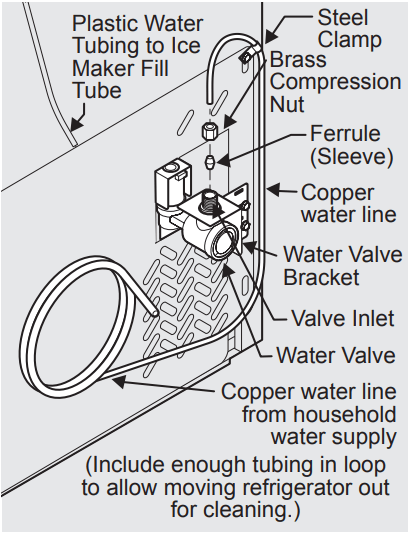
If you use stainless steel tubing - The nut and ferrule are already assembled on the tubing. Slide compression nut onto valve inlet and finger tighten compression nut onto valve. Tighten another half turn with a wrench; DO NOT over tighten
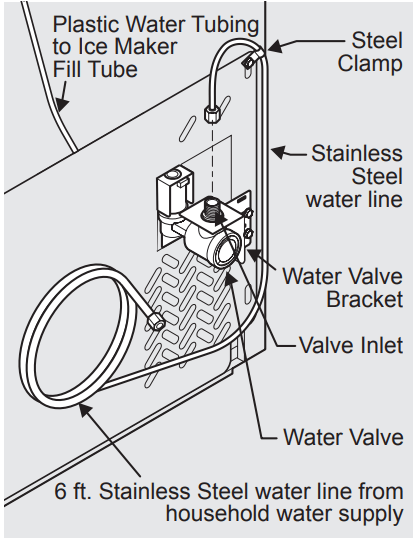
5. With steel clamp and screw, secure water supply line (copper tubing only) to rear panel of refrigerator as shown.
6. Coil excess water supply line (copper tubing only), about 2½ turns, behind refrigerator as shown and arrange coils so they do not vibrate or wear against any other surface.
7. Turn ON water supply at shutoff valve and tighten any connections that leak.
8. Reconnect refrigerator to electrical power source. 9 To turn ice maker on, lower wire signal arm (side mounted) or set the ice maker’s On/Off power switch to the “I” position (rear mounted).
IMPORTANT: After connecting the water supply, refer to “How to Prime the Water Supply System” for important information about priming an empty water supply system. Your refrigerator’s water supply system includes several tubing lines, a water filter, a water valve, and a water tank. To ensure that your water dispenser works properly, this system must be completely filled with water when your refrigerator is first connected to the household water supply line.
CONTROLS
Allowing Cooling Time Before Use
To ensure safe food storage, allow your refrigerator to operate with the doors closed for at least 8 to 12 hours before placing food inside. During this cooling period, you do not need to adjust the controls, which are preset at the factory.
Setting Cooling Temperatures
NOTE: When changing control settings, wait 24 hours for the temperature to stabilize before making additional changes
Your refrigerator comes with a state-of-the-art electronic digital control system. The system’s control panel is located at the top of the fresh food compartment.
The two digital displays on the left half of the control panel indicate the current settings or temperatures of your freezer and fresh food compartments. The models with a two-digit temperature display are for reference only, and do not display the current accurate compartment temperature. Should you desire to see what the current accurate temperature is, place a separate thermometer inside the freezer or fresh food compartment in the desired location.
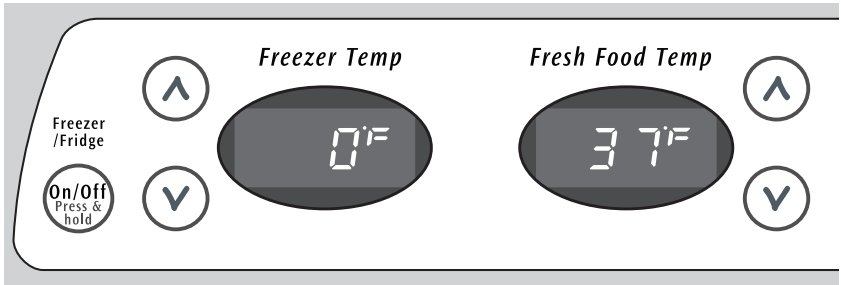
TEMPERATURE ADJUSTMENT
To adjust the temperature to a higher or lower setting, press the Up (Cold) or Down (Colder) button closest to the display. The first time you press the button, the display shows current setting you entered. Each press of the button after that changes the setting by one.
The display shows your new setting momentarily, then changes back to the current temperature.

ALARMS
Power Fail
In the event of a power failure, the ‘power fail’ alarm will sound three times. The ‘power fail’ alarm is an audible alarm only and does not display in the control panel.
High Temperature
When a warm refrigerator is first powered on, the ‘power fail’ alarm will sound and the current set points will be displayed for a few seconds. After 20 minutes the ‘high temp’ alarm will sound if the freezer temperature is above 26°F or if the fresh food temperature is above 55°F (or both are above).
If the unit is above the temperatures mentioned in the paragraph above, the affected compartment temperature display (fresh food, freezer or both) on the control panel will display ‘HI’ and an alarm will sound. To disable the alarm press any key on the control panel. After which the control panel will then show the display temperature. The unit will continue to monitor the product temperatures for ‘high temp’ condition every 20 minutes. If the ‘high temp’ condition persists, the alarm will sound again and can be reset again. Contact a customer service representative if the high temp alarm continues.
The audible portion of the alarm will silence itself once the product temperature is below 26°F for the freezer temperature and 55°F for the fresh food temperature. The control panel will still show ‘HI’ until it is acknowledged by the user by pressing any key on the control panel. After which the control panel will then show the display temperature.
Door Ajar
If the door has been left open for an extended period of time an alarm will sound. (Some models will have a ‘door ajar’ indicator on the control panel). The alarm will continue to sound until the door is closed.
Alarm Mute
Alarms can be muted (except ‘power fail’) by pressing a key combination on the control panel. Press and hold the ‘freezer temperature up’ key while at the same time pressing the ‘fresh food temperature down’ key three times. This sequence must be completed within 5 seconds for the alarms to be muted. Once the alarms have been muted, they will stay muted even if the refrigerator is powered down. To turn the alarm sounds back on, use the same key combination that was used to mute alarms.
IF TEMPERATURE DISPLAYS FLASH...
If ever you see “OP” or “SH” flashing, it may indicate that the control system has detected a performance problem. Call your service representative, who can interpret the flashing message.
To maintain temperatures, a fan circulates air in the refrigerator and freezer compartments. For good circulation, do not block cold air vents with food items.

Numeric Display
| Freezer | Fresh Food | |
| Warmest | 1 | 1 |
| Factory Setting | 6 | 6 |
| Coldest | 9 | 9 |
Temperature Control Range
| Freezer | Fresh Food | ||||
| Fahrenheit | Centigrade | Fahrenheit | Centigrade | ||
| Warmest | 6º | -14º | 47º | 8º | |
| Warmer | |||||
| Factory Setting | Midpoint | 0º | -18º | 37º | 3º |
| Colder | |||||
| Coldest | -6º | -21º | 33º | 1º | |
Temperature Adjustment
| If Fresh Food compartment is too warm | Adjust Fresh Food control one degree colder by pressing Down (Colder) button. |
| If Fresh Food compartment is too cold | Adjust Fresh Food control one degree colder by pressing Down (Colder) button. |
| If Freezer compartment is too warm | Adjust Freezer control one degree colder by pressing Down (Colder) button. |
| If Freezer compartment is too cold | Adjust Freezer control one degree colder by pressing Down (Colder) button. |
NOTE: The advanced electronic control system in your refrigerator includes additional display modes that service professionals can use to rapidly diagnose performance issues.
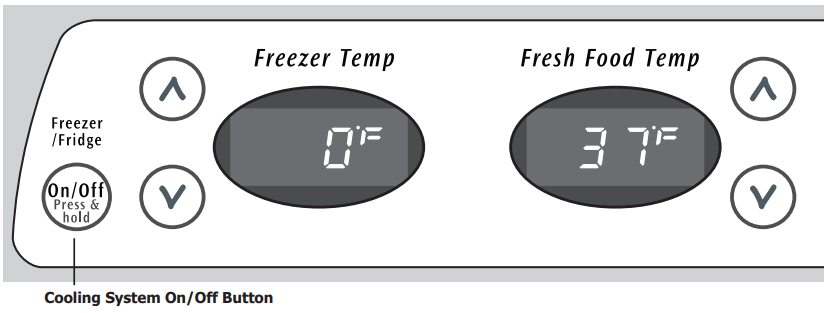
Turning the Cooling system on and off
You can disable the cooling system in your refrigerator by pressing the On/Off button located on the left side of the temperature control panel. To ensure that you do not accidentally turn off the cooling system, the button does not work unless you press and hold it for three seconds. Once you disable the cooling system, all refrigeration to the freezer and fresh food compartments stops. To turn the cooling system back on, you must again press and hold the On/Off button for three more seconds. Controls will display OF°F/OF°F when turned off.
NOTE: Pressing the On/Off button on the control panel disables your refrigerator’s cooling system but does not disconnect power to lights and other electrical components. To turn off power to your refrigerator you must unplug the power cord from the wall outlet. Each time you make settings on the control panel, a single audible tone acknowledges your input.
STORAGE FEATURES
CAUTION: To avoid personal injury or property damage, handle tempered glass shelves carefully. Shelves may break suddenly if nicked, scratched, or exposed to sudden temperature change. Allow the glass shelves to stabilize to room temperature before cleaning. Do not wash in dishwasher.
Cantilever Shelf Adjustment
Refrigerator shelves are easily adjusted to suit individual needs. Before adjusting the shelves, remove all food. Cantilever shelves are supported at the back of the refrigerator.
To adjust cantilever shelves:
1. Lift front edge up.
2. Pull shelf out.

Replace the shelf by inserting the hooks at rear of the shelf into the wall bracket. Lower the shelf into the desired slots and lock into position.
SpillSafeTM glass shelves (some models) catch and hold accidental spills. In some models, the SpillSafeTM shelves slide out for easy access to food and for fast cleaning. The shelves slide out independently of their mounting brackets. Just pull the front of the shelf forward. Shelves can be extended as far as the stopper will allow but are not removable from their mounting brackets.
Door storage
Door bins and shelves are provided for convenient storage of jars, bottles, and cans. Frequently used items can be quickly selected.
Some models have door bins that can accommodate gallon-sized plastic drink containers and economy-sized jars and containers. Some bins are adjustable for maximum storage capacity.
The dairy compartment, which is warmer than the general food storage section, is intended for short term storage of cheese, spreads, or butter.
Fresh Drawers with Humidity Control (some models)
The fresh drawers, located under the bottom refrigerator shelf, are designed for storing fruits, vegetables, and other fresh produce. The fresh drawers feature humidity control which allows you to adjust the humidity within the drawer. This can extend the life of fresh vegetables that keep best in high humidity. Wash items in clear water and remove excess water before placing them in the crispers. Items with strong odors or high moisture content should be wrapped before storing.
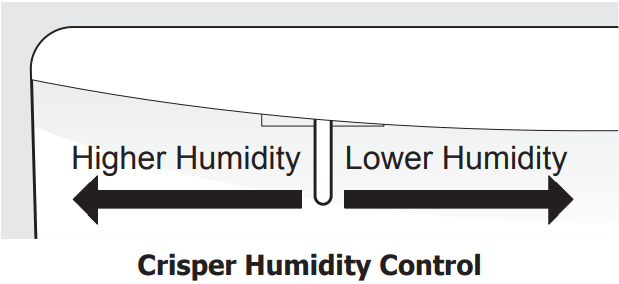
NOTE: Leafy vegetables keep best when stored with the humidity control set on Higher Humidity, or in a drawer without a Humidity Control. This keeps incoming air to a minimum and maintains maximum moisture content.
Crispers
Crispers allow you the flexibility to store any manner of items including fruits, vegetables, nuts, etc. Crispers do not feature humidity controls.

Cool Drawer (some models)
Some models are equipped with a Cool Drawer for storage of luncheon meats, spreads, cheeses, and other deli items. This drawer does not have a separate temperature control.
Chill Drawer (some models)
Some models are equipped with a Chill Drawer. Chill Drawer temperatures can be adjusted by sliding the Chill Drawer Temperature Control in either direction. Use this pan for short term storage of bulk meat items. If meats are to be kept longer than one or two days, they should be frozen. The Chill Drawer is fixed and cannot be moved up or down. If fruits or vegetables are to be stored in the Chill Drawer, set the Chill Drawer Temperature Control to a warmer setting to prevent freezing.
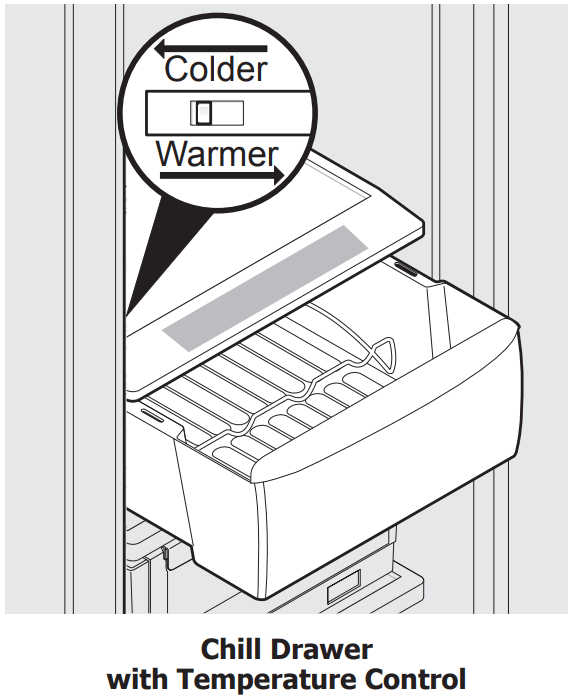
AUTOMATIC ICE & WATER DISPENSER

NOTE: Your refrigerator may have some or all of the features listed below. Become familiar with these features and their use and care.
| EXTREME FREEZE | To freeze food at a faster rate to preserve freshness, push the Touch Pad for 3-5 seconds to activate this feature. A green light will appear above the Touch Pad. Push the Touch Pad again for 3-5 seconds to deactivate. |
| EXTRA ICE | To increase ice production for special occasions, such as parties, push the Touch Pad for 3-5 seconds to activate this feature. A green light will appear above the Touch Pad. Push the Touch Pad again for 3-5 seconds to deactivate. EXTRA ICE should produce 25 percent to 50 percent more ice every 24 hours. |
| CUBE | Press the CUBE Touch Pad to get cubed ice. A green light will appear above the Touch Pad. Press glass against ICE dispensing paddle as far up as possible to catch all ice. |
| CRUSH | Press the CRUSH Touch Pad to get crushed ice. A green light will appear above the Touch Pad. Press glass against ICE dispensing paddle as far up as possible to catch all ice. |
| LIGHT | Press the LIGHT Touch Pad to turn on dispenser light. Press again to turn the light off. The light also turns on automatically when ice and/or water is dispensed. Replace light bulb with an appliance bulb of the same wattage. |
| FILTER STATUS | The FILTER STATUS indicator light above the Touch Pad will light up each time the dispenser is used. The following filter light indications are: Green The filter is still operating within its specified life cycle. Amber The filter has reached approximately 80 percent of its useful life. This is the recommended time to purchase a replacement filter. Red The filter is 100 percent used up. Change the filter as soon as possible. After the filter cartridge has been changed, press and hold the FILTER RESET Touch Pad for 10-15 seconds. NOTE: The Green, Amber and Red lights will flash when reset is completed. |
| LOCK | The Ice & Water Dispenser can be locked out to prevent unwanted use. To Lock Out Press the LOCK Touch Pad for 3-5 seconds. A red light will appear above the Touch Pad. To Unlock Press the LOCK Touch Pad for 3-5 seconds until the red light above the Touch Pad goes out. |
| WATER | To operate the water dispenser, press a glass against the WATER dispensing paddle. To stop dispensing water, pull the glass away from the dispensing paddle. Dispensed water is not cold. For colder water, add crushed ice or cubes before dispensing water. A drip tray located at the base of the dispenser catches small spills and allows them to evaporate. This drip tray is removable and dishwasher safe. Do not pour water and excess ice in this area because there is no drain. |
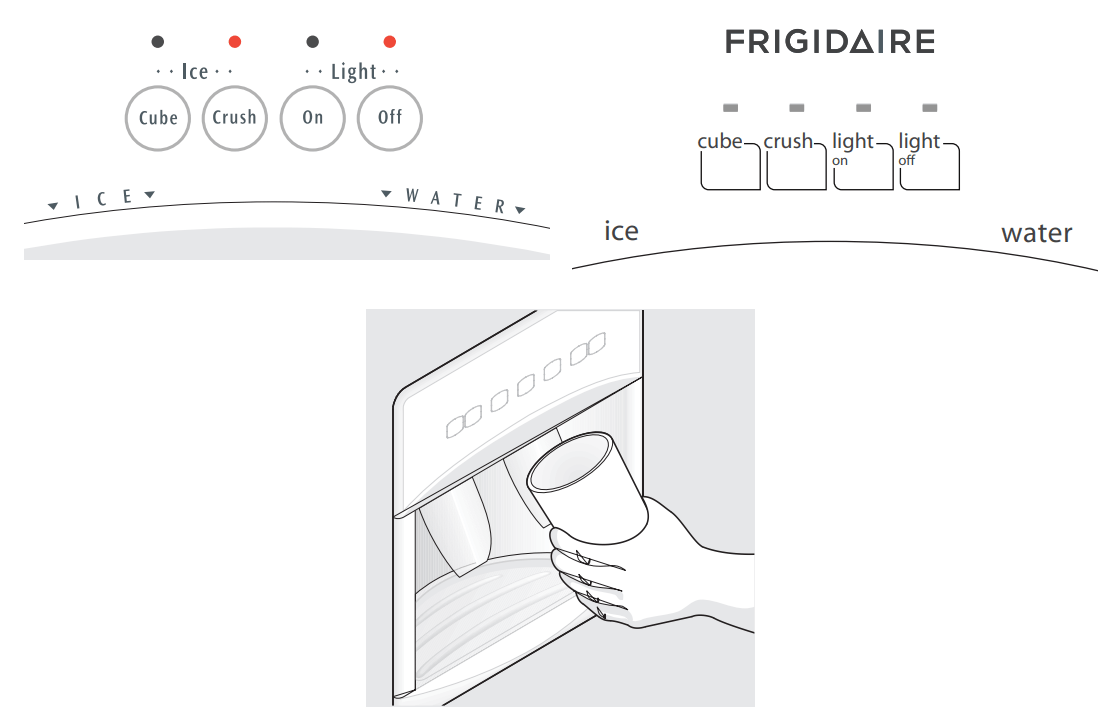
NOTE: Your refrigerator may have some or all of the features listed below. Become familiar with these features and their use and care.
| Crushed | Press the Crushed Touch Pad to get crushed ice. A red indicator will appear above the Touch Pad. Press glass against ICE dispensing paddle as far up as possible to catch all ice. |
| Cubed | Press the Cubed Touch Pad to get cubed ice. A red indicator will appear above the Touch Pad. Press glass against ICE dispensing paddle as far up as possible to catch all ice. |
| Light On | Press the Light On Touch Pad to turn on dispenser light. A red indicator will appear above the Touch Pad. |
| Light Off | Press the Light Off Touch Pad to turn off dispenser light. A red indicator will appear above the Touch Pad. |
| Water | To operate the water dispenser, press a glass against the WATER dispensing paddle. To stop dispensing water, pull the glass away from the dispensing paddle. Dispensed water is not cold. For colder water, add crushed ice or cubes before dispensing water. A drip tray located at the base of the dispenser catches small spills and allows them to evaporate. This drip tray is removable and dishwasher safe. Do not pour water and excess ice in this area because there is no drain. |
Priming the Water Supply System
Your refrigerator’s water supply system includes several tubing lines, an advanced water filter, a distribution valve bank, and a reserve tank to ensure ample supply to the ice and water dispenser at all times. This system needs to be completely filled with water when first connected to an external supply line.
CAUTION: For proper dispenser operation, recommended water supply pressure should fall between 30 psi and 100 psi. Excessive pressure may cause water filter to malfunction.
To prime the water supply system:
1 Begin filling the tank by pressing and holding a drinking glass against the water dispenser paddle.
2 Keep the glass in this position until water comes out of the dispenser. It may take about 1½ minutes.
3 Continue dispensing water for about four minutes to flush the system and plumbing connections of any impurities (stopping to empty the glass as necessary).
NOTE: The water dispenser has a built-in device that shuts off the water flow after three minutes of continuous use. To reset this shutoff device, simply release the dispenser paddle.
Ice Maker Operation & Care
The ice maker, ice bin, and dispenser feeding mechanism are located in the top of the freezer compartment. After the refrigerator is installed properly and has cooled for several hours, the ice maker can produce ice within 24 hours. It can completely fill an ice bin in about two days.
Ice Production: What to Expect
How Much Ice Will a Side Mounted Ice Maker Produce in 24 Hours?
A side mounted ice maker will produce 4 to 4.5 pounds of ice every 24 hours, depending on usage conditions. Ice is produced at a rate of 8 cubes every 75 to 90 minutes.
How Much Ice Will a Rear Mounted Ice Maker Produce in 24 Hours?
A rear mounted ice maker will produce 3 to 4 pounds of ice every 24 hours, depending on usage conditions. Ice is produced at a rate of 8 cubes every 75 to 90 minutes.
Using the Ice Maker after Installation
Before making ice for the first time, be sure to prime the water supply system. Air in new plumbing lines can result in two or three empty ice maker cycles. Furthermore, if the system is not flushed, the first ice cubes may be discolored or have an odd flavor.
IMPORTANT: Your ice maker is shipped from the factory with the wire signal arm in the ON position (side mounted) or with the switch turned ON (rear mounted). To ensure proper function of your ice maker, hook up water supply immediately or turn ice maker OFF by lifting the wire signal arm until it clicks and locks in the UP position (side mounted) or turn the On/Off switch to the Off (0) position (rear mounted). If the ice maker is not turned off and the water supply is not connected, the water valve will make a loud chattering noise.
Turning the SIDE MOUNTED Ice Maker On and Off
To begin ice production, lower the wire signal arm to the DOWN or ON position. The ice maker turns off automatically when the ice container becomes full. To stop the ice maker, raise the wire signal arm until it clicks and locks in the UP or OFF position.
Turning the REAR MOUNTED Ice Maker On and Off
Ice production is controlled by the ice maker’s ON/OFF power switch. To gain access to the ice maker, pull the ice cream shelf out. Press the switch to the “O” position to turn it Off and press it to the “I” position to turn it On. The ice maker also has a built-in wire signal arm, which automatically stops ice production when the ice bin is full. DO NOT use this signal arm to manually stop the ice maker.

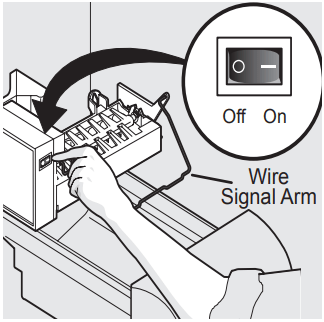
IMPORTANT: Small ice cubes or ice chips jamming in the ice maker may be a sign that your water filter needs changing. If you have a side mounted ice maker you may also experience hollow cubes partially frozen cubes with water inside. When these cubes are harvested, they break open and spill water over the other ice cubes in the ice container, forming a solid mass of ice. As the water filter nears the end of its useful life and becomes clogged with particles, less water is delivered to the ice maker during each cycle. The ice maker can’t fill every cube in the ice maker mold, leading to small cubes or chips that can get caught between the ice ejector blades and the stripper. Remember, if your ice maker is jamming with small ice cubes or it’s been six months or longer since you last changed your water filter replace the water filter with a new one. Poor quality household water may require the filter to be changed more frequently
Ice Maker/Dispenser Tips
- Ice cubes stored too long may develop an odd flavor. Empty the ice container as explained below. Occasionally shake the ice container to keep ice separated.
- If your refrigerator is not connected to a water supply or the water supply is turned off, turn Off the ice maker.
- If you need a large quantity of ice at one time, it is best to get cubes directly from the ice container.
- The following sounds are normal when the ice maker is operating:
- Motor running
- Ice dropping into ice container
- Water valve opening or closing
- Ice loosening from tray
- Running water
- When dispensing ice, you will hear a snapping or clicking sound when the ice chute opens and closes.
- Turn Off the ice maker when cleaning the freezer and during vacations.
- If you turn Off the ice maker for a long period of time, you should also turn off the water supply valve.
CAUTION: Chemicals from a malfunctioning water softener can damage the ice maker. If the water supply to your refrigerator is softened, be sure the softener is maintained to work properly.
Cleaning the Ice Maker
Clean the ice maker and ice bin at regular intervals, particularly before you take a vacation or move.
To clean the ice maker:
- Turn Off the ice maker.
- Remove the ice bin by lifting up and out.
- Empty and carefully clean the ice bin with mild detergent. Rinse with clear water. Do not use harsh or abrasive cleaners.
- Allow the ice bin to dry completely before replacing in the freezer.
- Remove ice chips and clean the ice bin shelf and the freezer door chute.
- Replace the ice bin. Turn On the ice maker to resume ice production.
Remove and empty the ice storage bin if:
- An extended power failure (one hour or longer) causes ice cubes in the ice storage bin to melt and freeze together, jamming the dispenser mechanism.
- You do not use the ice dispenser frequently. Ice cubes will freeze together in the bin, jamming the dispenser mechanism.
Remove the ice storage bin and shake to loosen the cubes or clean as explained above.
CAUTION: NEVER use an ice pick or similar sharp instrument to break up the ice. This could damage the ice storage bin and dispenser mechanism.
IMPORTANT: When removing or replacing the ice bin, DO NOT rotate the auger in the ice bin. If the auger is accidentally rotated, you must realign the auger by turning it in 90 degree turns (see below) until the ice bin fits into place with the drive mechanism. If the auger is not properly aligned when replacing the ice bin, the refrigerator will only dispense Crushed Ice. The freezer door may also not close properly causing warm air to leak into the freezer.
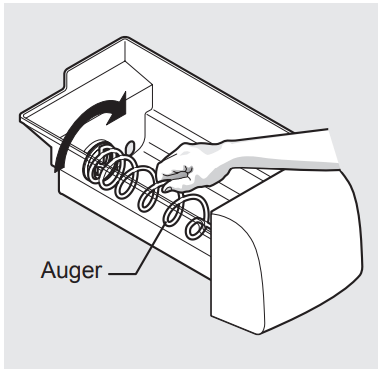
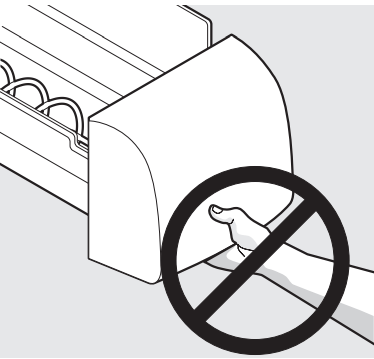
NORMAL OPERATING SOUNDS AND SIGHTS
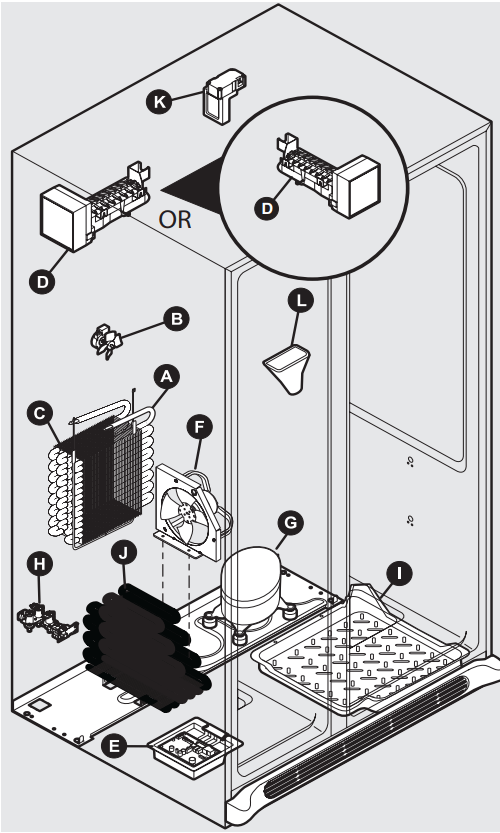
Understanding the Sounds you may Hear
Your new, high-efficiency refrigerator may introduce unfamiliar sounds. These sounds normally indicate your refrigerator is operating correctly. Some surfaces on floors, walls, and kitchen cabinets may make these sounds more noticeable.
Following is a list of major components in your refrigerator and the sounds they can cause:
A Evaporator Refrigerant through the evaporator may create a boiling or gurgling sound.
B Evaporator fan You may hear air being forced through the refrigerator by the evaporator fan.
C Defrost heater During defrost cycles, water dripping onto the defrost heater may cause a hissing or sizzling sound. After defrosting, a popping sound may occur.
D Automatic ice maker When ice has been produced, you will hear ice cubes falling into the ice bin.
E Electronic control & automatic defrost control These parts can produce a snapping or clicking sound when turning the cooling system on and off.
F Condenser fan You may hear air being forced through the condenser.
G Compressor Modern, high-efficiency compressors run much faster than in the past. The compressor may have a highpitched hum or pulsating sound.
H Water valve Makes a buzzing sound each time it opens to fill the ice maker.
I Drain pan (not removable) You may hear water dripping into the drain pan during the defrost cycle.
J Condenser May create minimal sounds from forced air.
K Motorized damper May produce a light humming during operation.
L Ice chute When dispensing ice, you will hear a snapping or clicking sound when the solenoid opens and closes the ice chute.
NOTE:
- Energy efficient foam in your refrigerator is not a sound insulator.
- During automatic defrost cycle, a red glow in the back wall vents of your freezer compartment is normal.
CARE & CLEANING
Protecting your investment
Keeping your refrigerator clean maintains appearance and prevents odor build-up. Wipe up any spills immediately and clean the freezer and fresh food compartments at least twice a year. When cleaning, take the following precautions:
- Never use CHLORIDE or cleaners with bleach to clean stainless steel.
- Do not wash any removable parts in a dishwasher.
- Always unplug the electrical power cord from the wall outlet before cleaning.
- Remove adhesive labels by hand. Do not use razor blades or other sharp instruments which can scratch the appliance surface.
Do not remove the serial plate. Do not use abrasive cleaners such as window sprays, scouring cleansers, brushes, flammable fluids, cleaning waxes, concentrated detergents, bleaches or cleansers containing petroleum products on plastic parts, interior doors, gaskets or cabinet liners. Do not use paper towels, metallic scouring pads, or other abrasive cleaning materials or strong alkaline solutions.
NOTE: If you set your temperature controls to turn off cooling, power to lights and other electrical components will continue until you unplug the power cord from the wall outlet.
CAUTION:
- Pull the refrigerator straight out to move it. Shifting it from side to side may damage flooring. Be careful not to move the refrigerator beyond the plumbing connections.
- Damp objects stick to cold metal surfaces. Do not touch refrigerated surfaces with wet or damp hands.
- Sudden temperature changes can cause glass breakage.
IMPORTANT: If you store or move your refrigerator in freezing temperatures, be sure to completely drain the water supply system. Failure to do so could result in water leaks when the refrigerator is put back into service. Contact a service representative to perform this operation.
Care & Cleaning Tips
| Part | What To Use | Tips and Precautions |
| Interior & Door Liners | Soap and water Baking soda and water | Use two tablespoons of baking soda in one quart of warm water. Be sure to wring excess water out of sponge or cloth before cleaning around controls, light bulb or any electrical part. |
| Door Gaskets | Soap and water | Wipe gaskets with a clean soft cloth. |
| Drawers & Bins | Soap and water | Use a soft cloth to clean drawer runners and tracks. |
| Glass Shelves | Soap and water Glass cleaner Mild liquid sprays | Allow glass to warm to room temperature before immersing in warm water. |
| Toe Grille | Soap and water Mild liquid sprays Vacuum attachment | Vacuum dust from front of toe grille. Remove toe grille (see Installation Instructions). Vacuum backside, wipe with sudsy cloth or sponge. Rinse and dry |
| Exterior & Handles | Soap and water Non Abrasive Glass Cleaner | Do not use commercial household cleaners containing ammonia, bleach or alcohol to clean handles. Use a soft cloth to clean smooth handles. DO NOT use a dry cloth to clean smooth doors. |
| Exterior & Handles (Stainless Steel Models Only) | Soap and water Stainless Steel Cleaners | Never use CHLORIDE or cleaners with bleach to clean stainless steel. Clean stainless steel front and handles with non-abrasive soapy water and a dishcloth. Rinse with clean water and a soft cloth. Use a non-abrasive stainless steel cleaner. These cleaners can be purchased at most home improvement or major department stores. Always follow manufacturer’s instructions. Do not use household cleaners containing ammonia or bleach. NOTE: Always clean, wipe and dry with the grain to prevent scratching. Wash the rest of the cabinet with warm water and mild liquid detergent. Rinse well, and wipe dry with a clean soft cloth. |
| Replacing Light Bulbs | Unplug refrigerator Wear gloves Remove light cover Replace old bulb Replace light cover Plug in the refrigerator | CAUTION: Wear gloves when replacing light bulbs to avoid getting cut. Use same wattage when replacing bulb. |
BEFORE YOU CALL
| CONCERN | CAUSE | SOLUTION |
| AUTOMATIC ICE MAKER | ||
| Ice maker is not making any ice. | Ice maker wire signal arm is in the “up” or OFF position. | Move wire signal arm to the “down” or ON position (side mounted). |
| Ice maker power switch is Off. | Turn power switch to On (“I”) position (rear mounted). | |
| Ice maker has small cube caught in mechanism. | Remove small cube from ice maker. The ice and water filter cartridge may be clogged. Replace filter cartridge. | |
| Saddle valve on cold water pipe is clogged or restricted by foreign material. | Turn off household water line valve. Remove valve. Ensure that valve is not a self-piercing saddle valve. Clean valve. Replace valve if necessary | |
| Ice maker is not making enough ice. | Ice maker is producing less ice than you expect. | Side mounted ice maker should produce 4 to 4.5 pounds (approximately 4 quarts) of ice every 24 hours. A rear mounted ice maker should produce 3 to 4 pounds (approximately 3½ quarts) of ice every 24 hours. Quick Ice option should produce up to 50% more ice every 24 hours |
| Check to see if water dispenser is dispensing slower than normal. | If it is, replace the ice and water filter cartridge. | |
| Freezer control is set too warm. | Set freezer control to colder setting to improve performance of the ice maker. Allow 24 hours for temperature to stabilize. | |
| Ice maker will not stop making ice. | Ice maker wire signal arm is being held down by some item in the freezer. | Move item and release wire signal arm. Remove any ice cubes that are frozen together over the wire signal arm. |
| Ice cubes are freezing together. | Ice cubes are not being used frequently enough. | Remove ice container and discard ice from container. Ice maker will produce fresh supply. |
| Ice cubes are hollow (partially frozen cubes with water inside) | The ice and water filter cartridge may be clogged. Replace filter cartridge. | |
| Freezer control is set too warm. | Set freezer control to colder setting. Allow 24 hours for temperature to stabilize. | |
| DISPENSER (Ice & Water) | ||
| Dispenser will not dispense ice. | Dispenser lock out is engaged. | Press and hold control lock for three seconds. |
| There is no ice in the bin to be dispensed. | See the “Ice maker is not making any ice” section above | |
| The refrigerator doors are not completely closed. | Be sure the refrigerator doors are completely closed. | |
| Dispenser paddle has been pressed too long and the dispenser motor has overheated. | The motor overload protector will reset in about three minutes and then ice can be dispensed. | |
| Ice dispenser is jammed. | Ice has melted and frozen around auger due to infrequent use, temperature fluctuations, and/or power outages. | Remove ice container, thaw, and empty the contents. Clean container, wipe dry, and replace in proper position. When new ice is made, dispenser should operate. |
| Ice cubes are jammed between ice maker and back of ice container. | Remove ice cubes that are jamming the dispenser. | |
| Dispenser will not dispense water. | Dispenser lock out is engaged. | Press and hold control lock for three seconds. |
| Water filter not seated properly | Remove and reinstall the water filter. Be sure to push the filter firmly so that you hear it lock solidly into position. | |
| Water filter is clogged. | Replace filter cartridge. Be sure to remove protective caps and push the filter firmly so that you hear it lock solidly into position. | |
| Household water line valve is not open. | Open household water line valve. See CONCERN column AUTOMATIC ICE MAKER. | |
| Water has an odd taste and/ or odor. | Water has not been dispensed for an extended period of time | Draw and discard 10-12 glasses of water to freshen the supply |
| Unit not properly connected to cold water line. | Connect unit to cold water line that supplies water to the kitchen faucet. | |
| Water pressure is extremely low. | Cut-off and cut-on pressures are too low (well systems only). | Have someone turn up the cut-off and cut-on pressure on the water pump system (well systems only). |
| Reverse osmosis system is in regenerative phase. | It is normal for a reverse osmosis system to be below 20 psi during the regenerative phase. | |
| Water not cold enough. | As warmer tap water goes through the filter and enters the water tank the chilled water is pushed through to the dispenser. Once the chilled water is used up it will take several hours to bring the freshly replaced water to a cooler temperature. | Add ice to cup or container before dispensing water. |
| OPENING/CLOSING OF DOORS/DRAWERS | ||
| Door(s) will not close. | Door was closed too hard, causing other door to open slightly. | Close both doors gently. |
| Refrigerator is not level. It rocks on the floor when moved slightly. | Ensure floor is level and solid, and can adequately support the refrigerator. Contact a carpenter to correct a sagging or sloping floor. | |
| Refrigerator is touching a wall or cabinet. | Ensure floor is level and solid, and can adequately support the refrigerator. Contact a carpenter to correct a sagging or sloping floor. | |
| Drawers are difficult to move. | Food is touching shelf on top of drawer | Remove top layer of items in drawer. |
| Track that drawers slide on is dirty | Ensure drawer is properly installed on track | |
| Clean drawer, rollers, and track. | ||
| RUNNING OF REFRIGERATOR | ||
| Compressor does not run. | Freezer control is set to “OF” or “0”. | Set freezer control. |
| Refrigerator is in defrost cycle. | This is normal for a fully automatic defrost refrigerator. The defrost cycle occurs periodically, lasting about 30 minutes. | |
| Plug at electrical outlet is disconnected. | Ensure plug is tightly pushed into outlet. | |
| House fuse blown or tripped circuit breaker. | Check/replace fuse with a 15 amp timedelay fuse. Reset circuit breaker. | |
| Power outage. | Check house lights. Call local electric company. | |
| Refrigerator runs too much or too long. | Room or outside weather is hot. | It’s normal for the refrigerator to work longer under these conditions. |
| Doors are opened too frequently or too long. | Warm air entering the refrigerator causes it to run more. Open doors less often. | |
| Fresh Food/freezer door may be slightly open. | Ensure refrigerator is level. Keep food and contains from blocking door | |
| Freezer control is set too cold. | Set Fresh Food control to warmer setting until refrigerator temperature is satisfactory. Allow 24 hours for temperature to stabilize. | |
| Fresh Food/freezer gasket is dirty, worn, cracked, or poorly fitted. | Clean or change gasket. Leaks in door seal will cause refrigerator to run longer in order to maintain desired temperatures. | |
| Condenser is dirty. | Clean condenser | |
| Compressor goes off and on frequently. | Thermostat keeps the refrigerator at a constant temperature. | This is normal. Refrigerator goes on and off to keep temperature constant. |
| DIGITAL TEMPERATURE DISPLAY | ||
| Digital temperature displays are flashing. | Electronic control system has detected a performance problem. | Call your Frigidaire service representative, who can interpret any messages or number codes flashing on the digital displays. |
| WATER/MOISTURE/FROST INSIDE REFRIGERATOR | ||
| Moisture collects on inside of refrigerator walls. | Weather is hot and humid. | The rate of frost buildup and internal sweating increases. |
| Door is slightly open. | See PROBLEM column OPENING/CLOSING OF DOORS/DRAWERS. | |
| Water collects on bottom side of drawer cover. | Vegetables contain and give off moisture. | It is not unusual to have moisture on the bottom side of the cover. Move humidity control (some models) to lower setting. |
| Water collects in bottom of drawer. | Washed vegetables and fruit drain while in the drawer. | Dry items before putting them in the drawer. Water collecting in bottom of drawer is normal. |
| WATER/MOISTURE/FROST OUTSIDE REFRIGERATOR | ||
| Moisture collects on outside of refrigerator or between doors. | Weather is humid. | This is normal in humid weather. When humidity is lower, the moisture should disappear. |
| Door is slightly open, causing cold air from inside refrigerator to meet warm air from outside. | See PROBLEM column OPENING/CLOSING OF DOORS/DRAWERS. | |
See other models: FFHS2622MH FFHS2313LM FFHS2322MS FGHS2631PP FGHS2631PE
